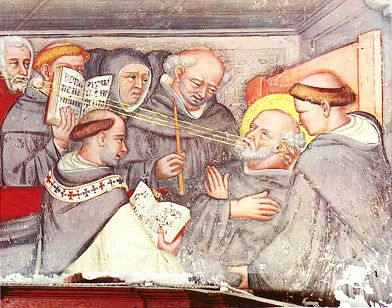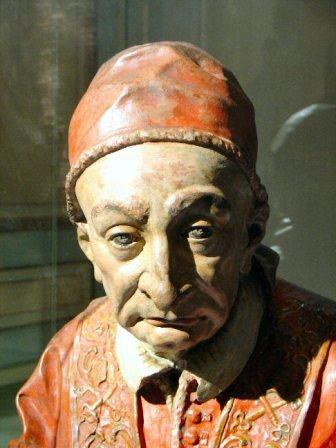Know your faith - The”New Mass”. In 1963, Pope Paul VI decreed that “the liturgical books are to be revised as soon as possible … and translated to the mother tongue.” In 2001, the Vatican issued, Liturgiam authenticam (2001), stating; “in translations of the liturgical texts from the official Latin originals, "the original text, insofar as possible, must be translated integrally and in the most exact manner, without omissions or additions in terms of their content, and without paraphrases or glosses.’ In the light of the new Latin version of the ‘Missal (2002), from which the translation must be made, the most obvious example was: “Dominus vobiscum” (The Lord be with you), and its reply; "Et cum spiritu tuo" (And with your spirit). This was at odds with the ‘73 translation where "And also with you" is used instead: this demonstrates the fundamental deviation from the Latin text. The International Commission for English in the Liturgy (ICEL) oversees the translation and presents these in sections to the bishops for comment (called The Green Book - in several versions) and for vote (The Gray Book). Eventually, this is passed to the pope for ratification. We are The Catholic (Universal) Church, and as English speakers, we are not in synergy with the rest of Catholicism in the Liturgical sense. So far, we are confronted with changes to the order of Holy Mass: in time, The Lectionary, The Breviary, The Ritual & Pontifical, The Martyrology and The Ceremonial of Bishops will follow.
Marius Vögel © 2009
Pope Paul VI Sacrosanctum Concilium, 4th December - Articles 25 & 36.4 (1963) International Committee on English in the Liturgy, Inc., The English translation of The Roman Missal © (1973)
Jorge A. Card. Medina Estévez, Prefect of The Congregation for Divine Worship and The Discipline of The Sacraments, Liturgiam authenticam (On The Use of Vernacular Languages in the publication of the books of The Roman Liturgy) Fifth Instruction “For the Right Implementation of the Constitution on The Sacred Liturgy of The Second Vatican Council” (Sacrosanctum Concilium, art. 36) 28 March 2001
International Commission for English in the Liturgy (ICEL), Official Website - News Page a Joint Commission of Catholic Bishops Conferences http://www.icelweb.org/news.htm
We are an inner city Johannesburg Catholic Parish Community, our Mission Statement reads: "We the people of St Anne’s, from diverse backgrounds, cultures and even countries, ask God for the Spirit’s Gifts of Faith, Love and Unity, that, as One Family, we may reach out to our neighbours, with the love and truth of the Gospel of Jesus Christ."
Monday, August 30, 2010
Most Popular Catholic Blogs
Top 25 Most Popular Catholic Blogs by Google Reader Subscribers
(1) What Does the Prayer Really Say?: 4841
(2) Whispers in the Loggia: 4685
(3) Charlotte Was Both: 3053
(4) Conversion Diary: 1817
(5) New Advent Blog: 1429
(6) Creative Minority Report: 1248
(7) Patrick Madrid: 1173
(8) Standing on my Head: 1156
(9) The Hermeneutic of Continuity: 1053
(10) Damian Thompson: 954
(11) Rorate Caeli: 933
(12) The New Liturgical Movement: 892
(13) Ask Sister Mary Martha: 867
(14) Mere Comments: 811
(15) Catholic and Enjoying It!: 796
(16) Ignatius Insight Scoop: 749
(17) By Sun and Candlelight: 712
(18) Catholic Cuisine: 648
(19) The Shrine of the Holy Whapping: 643
(20) Testosterhome: 638
(21) Happy Catholic: 607
(22) The Crescat: 573
(23) Domine, da mihi hanc aquam!: 521
(24) Shower of Roses: 481
(25) Wildflowers and Marbles: 474
(2) Whispers in the Loggia: 4685
(3) Charlotte Was Both: 3053
(4) Conversion Diary: 1817
(5) New Advent Blog: 1429
(6) Creative Minority Report: 1248
(7) Patrick Madrid: 1173
(8) Standing on my Head: 1156
(9) The Hermeneutic of Continuity: 1053
(10) Damian Thompson: 954
(11) Rorate Caeli: 933
(12) The New Liturgical Movement: 892
(13) Ask Sister Mary Martha: 867
(14) Mere Comments: 811
(15) Catholic and Enjoying It!: 796
(16) Ignatius Insight Scoop: 749
(17) By Sun and Candlelight: 712
(18) Catholic Cuisine: 648
(19) The Shrine of the Holy Whapping: 643
(20) Testosterhome: 638
(21) Happy Catholic: 607
(22) The Crescat: 573
(23) Domine, da mihi hanc aquam!: 521
(24) Shower of Roses: 481
(25) Wildflowers and Marbles: 474
Most Popular Catholic Blogs
The Relics of St Augustine
Augustine died on 28 August 430.

Sometime before the early 8th century, St Augustine’s remains were translated from North Africa to Sardinia for fear of desecration. It is possible that St. Fulgentius of Ruspe took Augustine’s body to Sardinia. Fulgentius had run foul of the Arian Vandals then in North Africa and was driven out.
During the 8th century Augustine’s remains were once more in danger , but this time by the Arabs who swarmed all over the Mediterranean as pirates and brigands in general.
Sometime between 710 and 730 King Liutprand of the Lombards translated St Augustine's relics a second time. On 11 October, Luitprand had the holy relics interred in Pavia in the church of San Pietro in Ciel d’Oro.
It is thought that Liutprand had to pay a huge sum to ransom the bones from some Muslim thug. (Hard to believe, I know.)
With the passage of time people simply forgot where the saints bones were actually located were in the church.
Eventually, the Church herself came to be controlled by two different Augustinian groups, the Canons Regular and the Hermits. Let’s just say their relations were strained and leave it at that. Then something happened that set off the war between them.
In 1695 a group of workman excavating under the altar in the crypt of the church found a marble box containing human bones. The box had some charcoal markings spelling the part of the word "Augustine", though those markings later disappeared. Great chaos ensued following the discovery.
The memory of just where St Augustine's relics were placed in the church, had been lost by the passing of time. Finding them again, set off a rather unpleasant battle concerning who had control ver the relics: the Augustinian Hermits and the Canons Regular.
Ultimately, Rome had to step in to resolve things. That’s what Popes do.

Pope Benedict XIII, a Dominican who changed his numbering from XIV to XIII so as to avoid being counting an anti-pope, got personally involved. He was very interested in saints and canonised the huge number of 18! At least that was a huge number before the pontificate of John Paul II.
This was also at the time when the future Pope Benedict XIV, Propsero Lambertini, published his fourth and final volume on the beatification of the servants of God and of the canonization of the blessed. Pope Lambertini would give us the legislation for the canonical processes of canonisations that has lasted with only a few changes to today.
In any event, Benedict XIII sent a letter to the Bishop of Pavia telling him to get their act together and figure out the questions of authenticity and control.
Additional studies were made under someone appointed by Benedict and by 19 September of 1729 things were wrapped up.
Processions were held, solemn proclamations made about the authenticity of the relics, a great Te Deum was sung and there was a fireworks display. Anyone who wanted to disagree and start the bickering again would be excommunicated. The good ol’ days.
The next year under Pope Clement XII the Cardinal Secretary of State (and a patron of the Canons Regular) commissioned the carving of the large main altar with its reliefs, completed in 1738, and which you can see today in the church where Augustine’s tomb is even now.
So, when you travel to northern Italy, be sure to stop in the interesting city of Pavia, south of Milan. There you will find the bones of the mighty north African Doctor of the Church, St. Augustine of Hippo.

Sometime before the early 8th century, St Augustine’s remains were translated from North Africa to Sardinia for fear of desecration. It is possible that St. Fulgentius of Ruspe took Augustine’s body to Sardinia. Fulgentius had run foul of the Arian Vandals then in North Africa and was driven out.
During the 8th century Augustine’s remains were once more in danger , but this time by the Arabs who swarmed all over the Mediterranean as pirates and brigands in general.
Sometime between 710 and 730 King Liutprand of the Lombards translated St Augustine's relics a second time. On 11 October, Luitprand had the holy relics interred in Pavia in the church of San Pietro in Ciel d’Oro.
It is thought that Liutprand had to pay a huge sum to ransom the bones from some Muslim thug. (Hard to believe, I know.)
With the passage of time people simply forgot where the saints bones were actually located were in the church.
Eventually, the Church herself came to be controlled by two different Augustinian groups, the Canons Regular and the Hermits. Let’s just say their relations were strained and leave it at that. Then something happened that set off the war between them.
In 1695 a group of workman excavating under the altar in the crypt of the church found a marble box containing human bones. The box had some charcoal markings spelling the part of the word "Augustine", though those markings later disappeared. Great chaos ensued following the discovery.
The memory of just where St Augustine's relics were placed in the church, had been lost by the passing of time. Finding them again, set off a rather unpleasant battle concerning who had control ver the relics: the Augustinian Hermits and the Canons Regular.
Ultimately, Rome had to step in to resolve things. That’s what Popes do.

Pope Benedict XIII, a Dominican who changed his numbering from XIV to XIII so as to avoid being counting an anti-pope, got personally involved. He was very interested in saints and canonised the huge number of 18! At least that was a huge number before the pontificate of John Paul II.
This was also at the time when the future Pope Benedict XIV, Propsero Lambertini, published his fourth and final volume on the beatification of the servants of God and of the canonization of the blessed. Pope Lambertini would give us the legislation for the canonical processes of canonisations that has lasted with only a few changes to today.
In any event, Benedict XIII sent a letter to the Bishop of Pavia telling him to get their act together and figure out the questions of authenticity and control.
Additional studies were made under someone appointed by Benedict and by 19 September of 1729 things were wrapped up.
Processions were held, solemn proclamations made about the authenticity of the relics, a great Te Deum was sung and there was a fireworks display. Anyone who wanted to disagree and start the bickering again would be excommunicated. The good ol’ days.
The next year under Pope Clement XII the Cardinal Secretary of State (and a patron of the Canons Regular) commissioned the carving of the large main altar with its reliefs, completed in 1738, and which you can see today in the church where Augustine’s tomb is even now.
So, when you travel to northern Italy, be sure to stop in the interesting city of Pavia, south of Milan. There you will find the bones of the mighty north African Doctor of the Church, St. Augustine of Hippo.
Subscribe to:
Posts (Atom)



